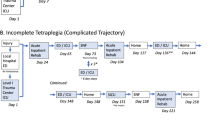Abstract
Study design
Explorative retrospective cohort study.
Objective
Secondary health conditions (SHCs) are common in people with spinal cord injury (SCI). To date, little is known about the effectiveness of long-term follow-up care in preventing SHCs. The objective of this study was to explore the therapeutic content of an interdisciplinary follow-up clinic by retrospective analyses of provided recommendations and collected data concerning SHCs.
Setting
Rehabilitation center Sint Maartenskliniek, The Netherlands.
Methods
All people with SCI, who visited one or more outpatient interdisciplinary follow-up clinics between January 2012 and October 2020 were included in this study. Treatment information was retrieved from their medical records.
Results
The 264 participants of the follow-up clinic received, after their first visit, an average of 3.9 recommendations regarding SHCs. Most recommendations were preventive in nature (43%), and were related to physical SHCs (61%). Most recommendations were followed by the participants (34% out of 40% that could be determined) and half of the underlying problems were solved (31% out of 62%). The bodyweight and respiratory function remained stable over time.
Conclusion
Participants of the interdisciplinary follow-up clinics received extensive recommendations on a variety of subjects, which most likely, reflects the interdisciplinary approach. Recommendations were followed-up to a large extent, resulting in solving half of the underlying SHCs. This way, worse SHCs were prevented by the recommendations. This findings, together with the stability of respiratory function and bodyweight, suggests the added value of the interdisciplinary follow-up clinic to usual care. More prospective research is necessary to investigate the (cost-)effectiveness.
Similar content being viewed by others
Log in or create a free account to read this content
Gain free access to this article, as well as selected content from this journal and more on nature.com
or
Data availability
The datasets used and/or analysed during the current study are available from the corresponding author on reasonable request.
References
Battalio SL, Jensen MP, Molton IR. Secondary health conditions and social role satisfaction in adults with long-term physical disability. Heal Psychol. 2019;38:445–54.
Bloemen-Vrencken JHA, Post MWM, Hendriks JMS, de Reus ECE, de Witte LP. Health problems of persons with spinal cord injury living in the Netherlands. Disabil Rehabil. 2005;27:1381–9.
Jensen MP, Truitt AR, Schomer KG, Yorkston KM, Baylor C, Molton IR. Frequency and age effects of secondary health conditions in individuals with spinal cord injury: a scoping review. Spinal Cord. 2013;51:882–92.
Gabbe BJ, Nunn A. Profile and costs of secondary conditions resulting in emergency department presentations and readmission to hospital following traumatic spinal cord injury. Injury. 2016;47:1847–55.
Munce SEP, Wodchis WP, Guilcher SJT, Couris CM, Verrier M, Fung K, et al. Direct costs of adult traumatic spinal cord injury in Ontario. Spinal Cord. 2013;51:64–9.
Chhabra HS. ISCoS text book on comprehensive management of spinal cord injuries. New Delhi: Wolters Kluwer; 2015.
Wade DT. What is rehabilitation? An empirical investigation leading to an evidence-based description. Clin Rehabil. 2020;34:571–83.
Dunn M, Love L, Ravesloot C. Subjective health in spinal cord injury after outpatient healthcare follow-up. Spinal Cord. 2000;38:84–91.
Cox RJ, Amsters DI, Pershouse KJ. The need for a multidisciplinary outreach service for people with spinal cord injury living in the community. Clin Rehabil. 2001;15:600–6.
Spreyermann R, Lüthi H, Michel F, Baumberger ME, Wirz M, Mäder M. Long-term follow-up of patients with spinal cord injury with a new ICF-based tool. Spinal Cord. 2011;49:230–5.
Bloemen-Vrencken JHA, De Witte LP, Post MWM. Follow-up care for persons with spinal cord injury living in the community: a systematic review of interventions and their evaluation. Spinal Cord. 2005;43:462–75.
Leochico CFD, Valera MJS. Follow-up consultations through telerehabilitation for wheelchair recipients with paraplegia in a developing country: a case report. Spinal Cord Ser Cases. 2020;6. https://doi.org/10.1038/s41394-020-0310-9.
van Asbeck FWA. Textbook of spinal cord injury rehabilitaion. 2nd ed. Houten: Bohn Stafleu van Loghum; 2007.
van Asbeck FWA, van Nes IJW. Textbook of spinal cord injury rehabilitation. Assen: Koninklijke van Gorcum; 2016.
Nazorg na dwarslaesierevalidatie - Richtlijn - Richtlijnendatabase. Federatie medische specialisten; 2017 https://richtlijnendatabase.nl/richtlijn/dwarslaesierevalidatie/nazorg_na_dwarslaesierevalidatie.html.
Von Elm E, Altman DG, Egger M, Pocock SJ, Gøtzsche PC, Vandenbroucke JP. The strengthening the reporting of observational studies in epidemiology (STROBE) statement: guidelines for reporting observational studies. UroToday Int J. 2009;2:20–2.
Dallmeijer AJ, Van Der Woude L, Van Kamp GJ, Hollander AP. Changes in lipid, lipoprotein and apolipoprotein profiles in persons with spinal cord injuries during the first 2 years post-injury. Spinal Cord. 1999;37:96–102.
De Groot S, Post MWM, Postma K, Sluis TA, Van Der Woude LHV. Prospective analysis of body mass index during and up to 5 years after discharge from inpatient spinal cord injury rehabilitation. J Rehabil Med. 2010;42:922–8.
Stolzmann KL, Gagnon DR, Brown R, Tun CG, Garshick E. Longitudinal change in FEV1 and FVC in chronic spinal cord injury. Am J Respir Crit Care Med. 2008;177:781–6.
Verberne DPJ, Kroese MEAL, Staals J, Ponds RWHM, van Heugten CM. Nurse-led stroke aftercare addressing long-term psychosocial outcome: a comparison to care-as-usual. Disabil Rehabil. 2020;0:1–9.
Allison R, Shelling L, Dennett R, Ayers T, Evans PH, Campbell JL. The effectiveness of various models of primary care-based follow-up after stroke: a systematic review. Prim Health Care Res Dev. 2011;12:214–22.
Fens M, Vluggen TP, Van Haastregt JC, Verbunt JA, Beusmans GH, Van Heugten CM. Multidisciplinary care for stroke patients living in the community: a systematic review. J Rehabil Med. 2013;45:321–30.
French DD, Campbell RR, Sabharwal S, Nelson AL, Palacios PA, Gavin-Dreschnack D. Health care costs for patients with chronic spinal cord injury in the veterans health administration. J Spinal Cord Med. 2007;30:477–81.
Verberne DPJ, Van Mastrigt GAPG, Ponds RWHM, Van Heugten CM, Kroese MEAL. Economic evaluation of nurse-led stroke aftercare addressing long-Term psychosocial outcome: a comparison to care-as-usual. BMJ Open. 2021;11:1–13.
Acknowledgements
We would like to thank Minke ter Stal and Mirke L’Herminez for their effort to retrieve all the information from the medical records of the participants.
Author information
Authors and Affiliations
Corresponding author
Ethics declarations
Competing interests
The authors declare no competing interests.
Ethics approval
The Medical Ethics Committee of the University Medical Center Radboud declared that this study (retrospective cohort study with anonymized data) did not need formal ethical approval under the Dutch law regulating medical research in human beings (reference number: 2021-7379). In accordance with local requirements, the Medical Ethics Committee of the Sint Maartenskliniek approved the conduct of this study in their center.
Additional information
Publisher’s note Springer Nature remains neutral with regard to jurisdictional claims in published maps and institutional affiliations.
Rights and permissions
About this article
Cite this article
van Diemen, T., Verberne, D.P.J., Koomen, P.S.J. et al. Interdisciplinary follow-up clinic for people with spinal cord injury: a retrospective study of a carousel model. Spinal Cord Ser Cases 7, 86 (2021). https://doi.org/10.1038/s41394-021-00451-0
Received:
Revised:
Accepted:
Published:
DOI: https://doi.org/10.1038/s41394-021-00451-0



